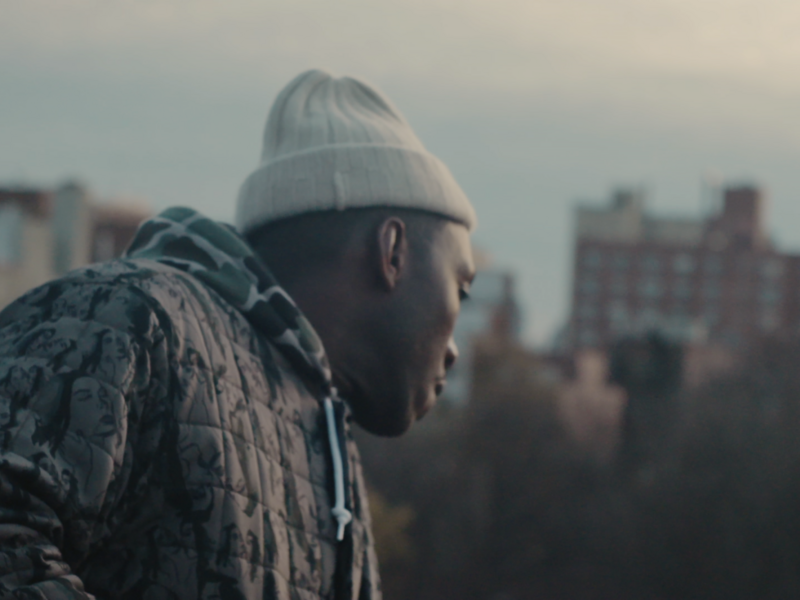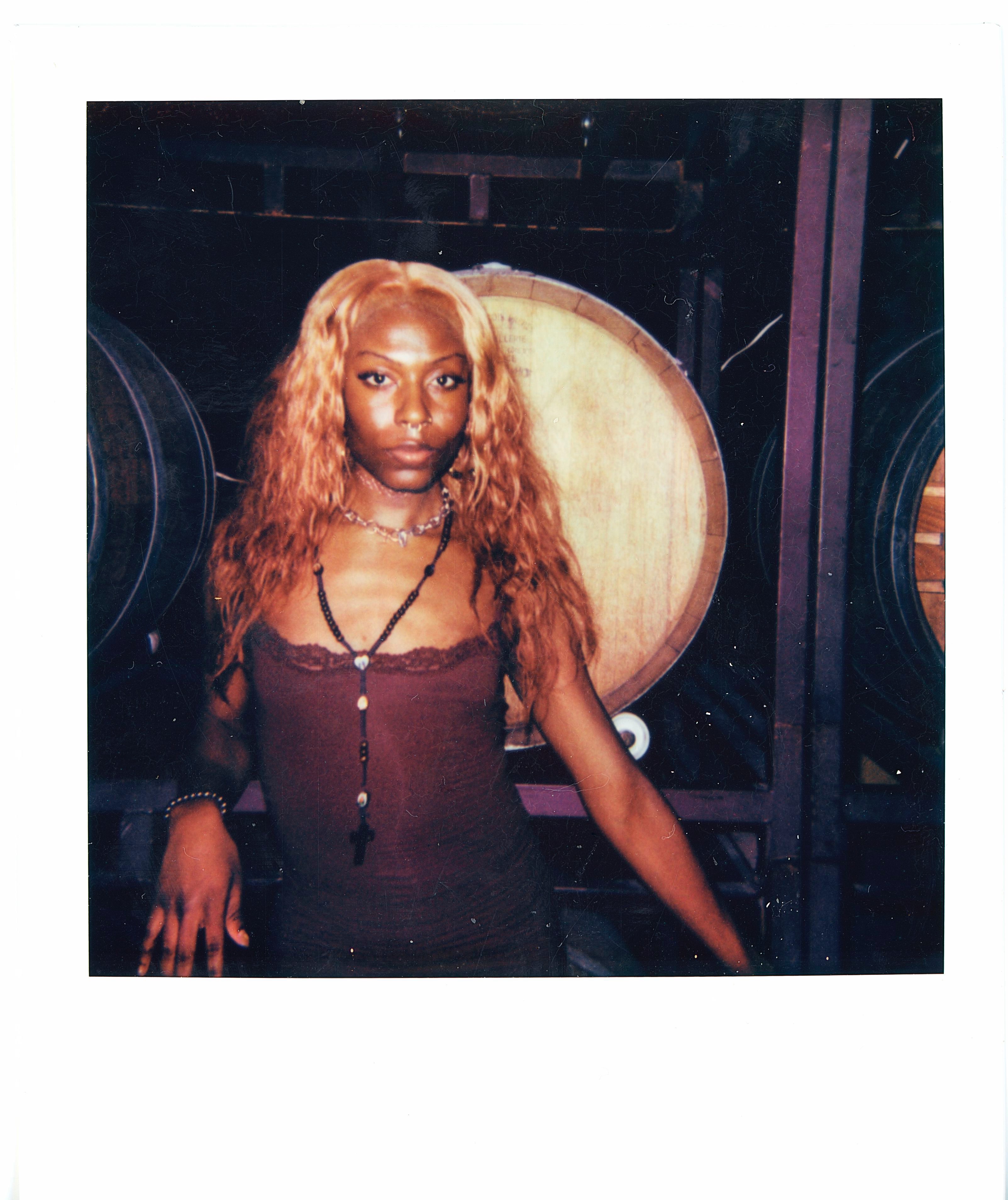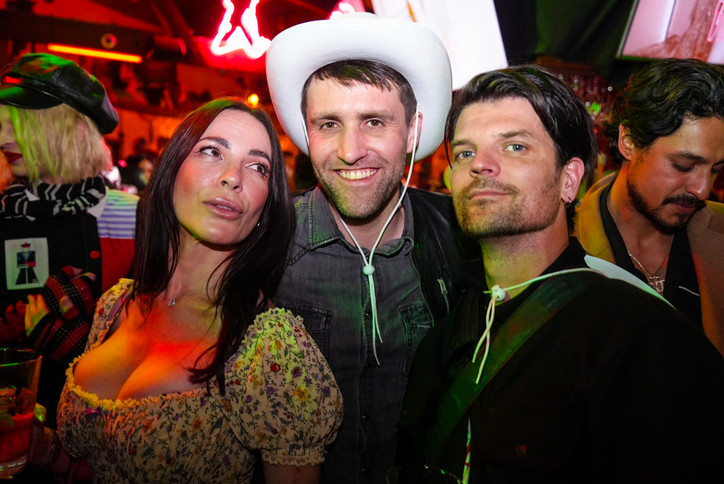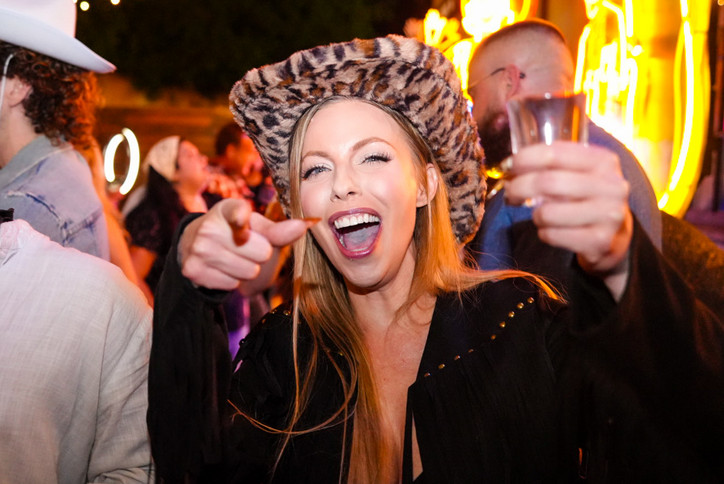Lil Buck: Walking on Water

But Buck, the man I spoke to over Zoom last week, is very human, and that may be one of the most incredible things about him. When we connect, he greets me with a genuinely huge smile, rare on this platform, and says, “How we doing today, Saam? I’m really excited to speak with you, man.” I had just spent the better part of a few straight days researching Buck and his art, something that seems outside of this reality, and he still greeted me as a friend.
It’s one of many surprising things about Lil Buck that I learned throughout our conversation. For someone of such great success as him, performing with world-class artists, being the face of Apple commercials, and starting his own dance company, he is exceedingly humble and cannot get through one sentence about himself without naming every person that is responsible for it. And perhaps that can explain Buck’s great success: his history reminds him of how far he has come, and it promises too how far he can go.
Charles “Lil Buck” Riley was born on May 25th, 1988 in Chicago, Illinois, where he lived with his mother, two older sisters, and younger brother for the first portion of his life. “I grew up poor in a very poor family,” he says. “We lived in my grandmother’s basement. We moved a lot, man.” Due to his mother’s struggles with abusive relationships and financial hardship, when Buck was eight, he and his family moved to Memphis where his father lived, whom Buck had never met before. “I found out I had three younger sisters on my dad’s side.”
It was difficult for Buck to make many strong friendships because it never felt like he stayed anywhere long enough to build the community he needed. “I never thought there was anything special about me,” he says. “There wasn’t anything I had to offer. I didn’t even know myself.”



Though, the one constant Buck had in his life was movement. “I’ve been dancing for as long as I can remember,” he remarks. “I started dancing seriously when I was thirteen. That’s when I knew I wanted to be a dancer.” Buck and his older sister Stephanie would dance together in their free time. “She was a majorette,” he says through his excited grin. “She’s always been dancing. She got me into dancing. It was a coping mechanism. It made me feel happy. It was the only thing that made me feel free.” And one of Buck’s favorite pastimes with his sister, apart from dancing, was watching old VHS tapes of Michael Jackson. “I thought he was some mythical being,” he reflects on Jackson. “We didn’t have YouTube. We didn’t know what was going on in the world. I thought you just had to be a special kind of person to move the way he did.”
But Buck stumbled upon myth in the streets of Memphis, watching older boys dance together and have battles with the Memphis-born dance style of jookin’. He first witnessed jookin’ when his sister came home from school one day and danced with precise, weightless control of her limbs that he had never seen before. She taught him what she knew and he became infatuated with the style. But Buck remembers one moment in particular that pulled a string in him that set him out on a lifetime of mastery in jookin’. “I was at the Crystal Palace Skate Rink in South Memphis,” he recalls. “Dancers would come to the skating rink because they would have the skaters come off the floor for the last hour that the rink was open and open up the floor to anyone who just wanted to come dance and have a good time. We’d see people battling. It was the first time I had seen people who were jookin’ for years.”
It was at the Crystal Palace, during one of the dance battles, that Buck saw Jeremy “Bobo” Greer, whom he calls one of the pioneers of Memphis jookin’. “When I saw Bobo, someone from my own neighborhood, someone who looked like me, with the baggie jeans and the long t-shirt with golds in his mouth, when I saw that guy glide across a carpet just like it was water, everything stood still.”
In one moment, the impossible became the present for Buck. “He was gliding just as smooth, if not smoother,” he offers, “and just as cold, as Michael Jackson.” He had a rare, priceless moment of revelation. The walls of possibility he had known collapsed. “I went home,” he says, “and I couldn’t stop thinking about the way he danced. I woke up in the morning and he was still gliding in my brain. And it never went away.”
If you look up “Memphis Jookin’” on Google, the first result is a video of Lil Buck performing at the Kennedy Center. It’s a dance style that most have probably never seen before seeing Buck perform it, but to Buck, jookin’ is a central part of what it means to be from Memphis. It was a part of the way people thought about things, Buck reports. “my mama used to do the Gangsta Walk back in the day,” an older version of jookin’ from the Memphis music scene, “and that came from just getting upppp!” Buck argues that jookin’ is just as close to people’s hearts as rock and roll, or the blues, or any of the Memphis legends like Elvis Presley and B.B. King. “It’s just as Memphis as barbecue,” he says. And for something so special to Memphis to have originated in the streets is one of the most beautiful parts of jookin’ to Buck.
When Buck started jookin’, he found that the form satisfied a lot more of the needs in his life than he had anticipated. “I was bullied a lot in school,” he reflects. “People misunderstood me. And my mom worked two jobs. I didn’t spend a lot of time with my family. I never really had any friends.” Jookin’, for Buck, went beyond his desire to escape through dance: it offered an opening into community at the heart of Memphis culture. “I wanted to be a part of something amazing,” he recalls. “I would wake up in the morning trying to learn how to do the moves. And I would stay up late at night perfecting them.”
Buck trained like this for years, dedicating most of his physical energy and mental space mastering jookin’. By the time he was sixteen, after three years of relentless training, he was beginning to formulate a sense of style and rhythm. “You have to do it a certain way for people to recognize it as jookin’, it has to be authentic to the culture” he stipulates, “But it's also a dance style that has a lot of room for your own creativity.” As Buck trained, he discovered that he had extremely flexible ankles and knees, which allowed for advanced improvisations of the form. Personalized evolutions of an art form—revolutionary diversions.
Once Buck had felt comfortable enough with jookin’ after a short three years, he accepted his first dance battle against his hometown idols. “I was nervous, I had never battled,” he says. “I was still a huge fanboy. Everybody was superstars to me. These guys were my personal Michael Jacksons.”
But in the Memphis scene, Buck couldn’t show any fear. He was determined to prove himself. He battled a fellow joker named TJ, who is now a close friend to Buck. “When I tell you I was nervous, man,” he smiles, “I was afraid I was gonna pee my pants.” But when the museum came on, Buck calmed. “I was a totally different person. I was ruthless.” Three years of training presented with an aggressive perfection performed to those whom he worked to replicate. He could finally call himself a Memphis jooker.
It was at this point that Buck enrolled in hip-hop dance classes, and eventually, Buck’s mother enrolled in a performing arts high school after a lifetime of switching schools. Stability and focus were found in the mastery of his form. He joined a hip-hop dance class to hone that introduced him to choreography outside of his private intuitions. He also learned ballet to build up his core, strengthen his footwork, and build greater patience, eventually earning a scholarship to perform with a ballet program. At this point, he felt well-rounded not only as a jooker but as a trained dancer—learning to walk by running.
As Buck entered adulthood, he took advantage of the emerging social media sphere, putting dance videos out on YouTube and Myspace. A film producer in LA discovered Buck and flew him and his cousin out to LA to shoot a video. “That was my first time on a flight,” he says. It was the first time Buck could dance for audiences outside of his hometown and he left people in total disbelief with his jookin’. The professional dancers that worked on the set he was hired for were so amazed by jookin’ that they relieved themselves from appearing in the video so that Buck and his cousin could show off.
After leaving LA, Buck kept in touch with the dancers he met, and they started reaching out urging Buck to move to LA so that he could continue to pursue dance. One friend offered to fly Buck out and let him crash but the friend could only afford a one-way ticket. He had already gained so much through jookin’ within his own community, but maybe it was time to show the world what his community was made of.
He took the ticket and started saying his goodbyes. “My mom was scared pantless,” he jokes. “She cared about me so much. She just wanted me to be alright.” With the little money they had, his mother gave him one hundred dollars to start in LA. “I didn’t know about the luggage fees,” he laughs, “so it actually ended up being around twenty dollars.”
He arrived in LA with a place to stay, twenty dollars in his pocket, and the drive to do the unimaginable, which was just enough to get off the ground. He would dance at the Santa Monica Pier to make extra money. Eventually, he signed with an agent and started doing commercials to sustain himself. He appeared on the Ellen Show. He co-choreographed a Janelle Monáe music video. And, eventually, he made contact with Yo-Yo Ma.
“That story begins back in Memphis,” Buck explains. The ballet company Buck belonged to in Memphis, New Ballet Ensemble & School would often do outreach programs to schools in the area. During a performance at a school in Little Rock, Arkansas, Buck performed a mix between jookin’ and ballet, something he and the director Katie Smythe would often experiment while practicing. The video ended up going viral.
While Buck was working in LA, Damian Woetzel, the president of The Julliard School and an appointee on the President’s Committee on the Arts and Humanities by President Obama, saw the video and wanted to work with Buck. He reached out to the ballet company and eventually found Buck on Facebook and asked him if he wanted to put a performance together with Yo-Yo Ma. “I was like, ‘Yo-Yo who?’” says Buck, but after researching Ma, he discovered Ma’s level of mastery and prestige that draws comparison to Buck himself. It so happens that Yo-Yo Ma is known for his rendition of “The Swan,” and Woetzel wanted to bring the two together to collaborate.
Buck went to the Disney Concert Hall in downtown LA to a performance by Ma where they planned to meet. “Yo-Yo gave me the biggest hug,” he remembers, “ and he says, ‘I want to try something,’ so we went out to the hallway and he started playing ‘The Swan,’ and I started dancing. It was magic.” They eventually coordinated a performance at a meeting between different creative celebrities to incorporate the arts in education that ended up in the viral video recorded by Spike Jonze.
What I originally loved so much about the video was the shocking departure from what I was used to seeing with the sort of classical music like “The Swan.” I expect careful, reserved expressions that find confidence in their surviving antiquation. I don’t expect what Lil Buck does. In a way, I felt embarrassed by my reaction to Lil Buck’s dancing. Why is it that we find discomfort in the pairing of art forms? What would be possible if we found ways to destroy the barriers of relation?
For an artist like Lil Buck, it’s not that his art asks these questions. Rather, his art is a rare moment of explanation. An answer, unexpected. When I ask him how it felt to jook with Yo-Yo Ma, he admits, “I can't even describe the feeling,” and continues, “it felt natural and it felt real for me because that was who I am.” To Buck, dancing with Yo-Yo Ma was a product of a lifetime of finding his voice. “I didn't grow up with much of a voice,” he says, “I didn't grow up thinking there was anything special about me. I knew that this was something I could speak to. This was something that people can understand.”
It was an unexpected moment for Buck, an accomplishment he didn’t expect to achieve, blending the conservative, elite, and aged world of classical music with Memphis jookin’, merging a world felt unattainable to someone like Buck with a form that, to him, was once unattainable. To destroy boundaries like this is deserving of a master that has himself has done the impossible already in his life. “To present street dancing like Memphis jookin’ to the classical world and have them see for themselves that street dancing an art form as any other dance, any other art,” he slows, “it’s beautiful. Like growing a rose out of concrete.”
Buck continued to grow and spread the message of Memphis jookin’ to all those who would look. Over the next ten years, he would dance with Madonna at the Super Bowl, model for fashion catalogs, perform with the New York City Ballet, organize more collaborations with Yo-Yo Ma, and appear in more Spike Jonze movies. And yet, even with all of these collaborations, it took time for Buck to create the sort of project that was by and for himself. Not “the jooker,” not, “the street dancer that performed with Yo-Yo Ma,” not, “Madonna backup dancer,” but just as Charles “Lil Buck” Riley.
“I’ve always wanted to touch on who I am as a person,” he explains, “I speak my truth in my dance but I never got a chance to tell my own story. I never got to express the traumas I went through.” Although he was appearing with some of the biggest names in all corners of the art world, he didn’t feel as though anyone knew who he was beyond the dancing.
Recently, Buck was teaching a dance class with Red Bull, who regularly sponsors dancers, and started speaking to different people at the company about creating a video. He got in touch with director David Javier to start on something, a video, that would just be about Buck.
Buck grew up close to the church with his parents being dedicated Christians. “I think choir is a big reason I got so passionate about dance,” he says. “I always thought the choir was where the holy ghost was. When they started singing, I couldn’t control myself. I would jump up and start moving. And my mom would scream and say, ‘My son got the holy ghost!’ These are the moments I never get to talk about.”
Buck told David about his past, everything he went through as a child, and how the recent Black Lives Matter protests were bringing out memories of his life in Memphis, dealing with police brutality and gun violence within his community. So they made a video, released one week ago, titled, “Nobody Knows,” a dance collaboration with Pastor T.L. Barrett and The Youth for Christ Choir. It’s a short video, a little less than five minutes, that tells a lifetime. A boy from Memphis, reaching outside of what is human, touching hands with God. A manifestation not only of personal history but also community memory. It encompasses pain and the love and hope found in common strength. And it’s a dance.
“I couldn't hold myself back,” Buck remembers. “I started to cry in some instances because it was something so personal to me and something that. I feel like I got to get off my chest and I got to speak through in the best way I knew. I'm actually speaking to your soul through dance, my truth. This was me out there naked.”
I half expect when I watch “Nobody Knows” for a singer to appear at some point in the video and begin to perform along with the themes, and yet it would feel out of place. “Nobody Knows” is a landmark for Buck as the central subject. It’s a departure from an empty sort of emotion that Superbowl dancers may know far better than Memphis street dancers: feeling like your work isn’t being seen. “Growing up jookin’,” Buck starts, “we take pride in the time and effort we have to do to cultivate this art that we've been growing. And we've been training ourselves. We're craftsmen, man. We're artists. We’re not just background dancers for other artists.”
While Buck reached heights in his career that he never expected growing up in Memphis, he found a surprising distance from the appreciation of his form the bigger he got, and it’s a problem all dancers in the industry face. “I'm working really hard to try to inspire the dance community,” he says. “Hone in on who you are as an artist and invest in that.” Buck feels especially passionate about making sure that those within the Black community, who are historically exploited within the dance sphere, are not undervaluing the power they have through movement. “This is a mission for me,” he states, “to show the Black kids in my community that they have a voice with their dance. You have power with your dance. As long as you focus and hone in on what you do, and work really hard at what you love. Don’t take no for an answer. You can make this happen for yourself.”
I can’t tell if Buck’s dancing is what it looks like to be touched by God, or if it’s the sort of thing that makes others believe they are witnessing an act of God. I imagine witnessing Lil Buck perform may feel similar to how it felt to witness the Chicago Bulls win their first NBA championship against the Magic Johnson LA Lakers led by a young man named Michael Jordan. Perhaps it is how those sitting in the Vivian Beaumont Theater felt when they saw a young woman named Whitney Houston perform “Home” on The Merv Griffin Show in 1983. It must have been what Lil Buck felt when he first saw Michael Jackson dancing on TV when he was a kid growing up in Memphis.
But, one of the most inspiring things I found in my conversation with Lil Buck was realizing that he doesn’t see himself the way that I or any of his admirers see him. After a lifetime of beating impossible odds, he reflects on his career with humility and compassion for young artists like the kid he was watching Michael Jackson on VHS.
“I’m not an anomaly,” he assures. “I’m not the only person who can do what I do. I’m not a special case. There are a lot of obstacles for us, being Black in this industry. It’s hard for the Black community, for people of color, to survive. This industry wasn’t made for us. But we set the tone. We are the trendsetters. Our culture is what people love. We have the power.”
I ask Buck, before we run out of time, to imagine a young kid in Memphis watching “Nobody Knows” on their computer and seeing the way Buck dances in the same way he looked at Michael Jackson. He smiled and closed his eyes for a moment and took a deep breath. I then asked him, if he could say anything to that kid, what would it be?
“Wow,” he begins. “Thinking about what I’ve been through and what I thought as a kid, what it all took. I would just tell him, ‘Man, you should dream big. Dream as big as you possibly can, because no dream is too big.’” He smiles at me and begins to laugh. “You know,” he says through a chuckle, “when I was a kid, my biggest dream was to be a backup dancer!” Watching backup dancers when he was younger, Buck assumed they were just as well paid and just as well respected as the singer, getting up close to the singer, looking better than the musician. They added just as much to the art, so they should be just as lauded. And yet, although he may be right, such is not the reality.
“So, man,” he continues, “I would tell that kid to dream as big as they possibly can. From my experience, no dream is too big, and your dreams may not even be big enough for what you can do. You gotta go for it. You gotta work hard at what you love, for what you believe, for what you want to have happen for yourself. If what you love is dance, take the time to learn, have patience, learn the craft. Be a craftsman! Dream as big as you can.”








































